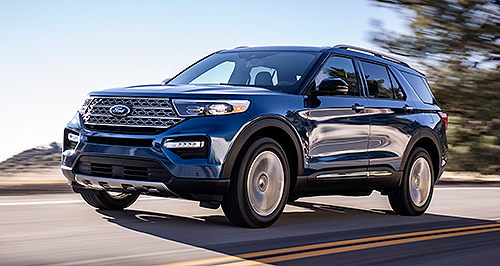Make / Model Search
Future models - Ford - ExplorerFord targets US with LHD-only ExplorerRear-wheel-drive shift headlines new Ford Explorer as Australia misses out – again11 Jan 2019 FORD has revealed the sixth-generation Explorer large SUV that will target high-volume left-hand-drive markets, headlined by the US, with Australia set to miss out yet again due to right-hand-drive production not being planned.
The Blue Oval’s local arm will instead focus on its existing SUV line-up that recently expanded with the addition of the large-size Endura, which is known as Edge overseas.
The five-seat, diesel-only Endura is at odds with most of its sub-$70,000 rivals that instead feature seven seats and petrol engines, while it is viewed in some circles as the spiritual successor to the locally built Territory that ended production in October 2016.
Conversely, with its move to the recently unveiled Lincoln Aviator’s rear-wheel-drive platform, the Explorer is new from the ground up and exclusively offered as a seven-seater with petrol engines, making it more closely aligned with market expectations.
The Explorer is available with a pair of EcoBoost turbocharged units, including a 224kW/420Nm 2.3-litre four-cylinder and a 272kW/515Nm 3.0-litre V6 and, while hybrid and performance-focused ST variants are confirmed but yet to be detailed. A 10-speed torque-convertor automatic transmission is standard.
A new Terrain Management System increases the Explorer’s off-road capability, featuring seven driving modes – Normal, Sport, Trail, Slippery, Tow/Haul and Eco – while all-wheel-drive variants add Deep Snow/Sand.
When properly equipped, maximum braked towing capacity for the Explorer’s 2.3- and 3.0-litre engines is 2404kg (+1043kg) and 2540kg (+272kg) respectively.
Inside, a portrait-orientated 10.1-inch touchscreen is powered by Ford’s Sync3 infotainment system, while a 12.3-inch digital instrument clusters completes the cabin’s technological tour de force alongside Apple CarPlay and Android Auto support, wireless smartphone charging and a 4G Wi-Fi hotspot.
Cargo capacity with the power-folding rear seats and one-hand manual-release second row stowed is 2486L, while 123L of storage space is found elsewhere in the cabin.
Advanced driver-assist systems extend to front and rear autonomous emergency braking with pedestrian detection, lane-keep and steering assist, blind-spot monitoring, cross-traffic alert, adaptive cruise control with stop and go functionality, speed limit recognition and park assist, plus Post-Impact Braking, and Evasive Steering Assist.
According to Ford Motor Company head of product development and purchasing Hau Thai-Tang, the changes made to the Explorer were a direct result of customer feedback.
“Explorer drivers told us what they want – more capability, more power, more space,” he said. “They want more technology, not just for the driver, but for the whole family. And they want all of it with a beautifully sporty exterior. This new Explorer gives them all of that, and more, helping make every journey more enjoyable.”
As reported, the ladder-frame second- and third-generation Explorer were sold in Australia from 1996 to 2007, but the home-grown Territory quickly sealed its fate when it launched in April 2004.
The monocoque fourth- and fifth-generation models were not produced in right-hand drive and specifically targeted the US market, among others.  Read more16th of January 2018  Detroit show: Ford evaluating RHD ExplorerSeven-seat Explorer could fill gap in Ford’s line-up as Toyota Kluger rival26th of May 2005  Exit the ExplorerFord Explorer SUV in no man’s land as Falcon wagon survives - for nowAll future models Alfa Romeo Alfa Romeo Abarth Abarth Alpine Alpine Alpina Alpina Audi Audi Aston Martin Aston Martin BMW BMW Bentley Bentley Chery Chery Brabham Brabham Chrysler Chrysler Chevrolet Chevrolet Cupra Cupra Citroen Citroen DS DS Dodge Dodge Fiat Fiat Ferrari Ferrari Foton Foton Ford Ford Great Wall Great Wall FPV FPV Haval Haval GWM GWM Honda Honda Holden Holden Hummer Hummer HSV HSV Infiniti Infiniti Hyundai Hyundai Jaguar Jaguar Isuzu Isuzu Kia Kia Jeep Jeep Land Rover Land Rover Lamborghini Lamborghini Lexus Lexus LDV LDV Mahindra Mahindra Lotus Lotus Mazda Mazda Maserati Maserati Mercedes-AMG Mercedes-AMG McLaren McLaren MG MG Mercedes-Benz Mercedes-Benz Mitsubishi Mitsubishi Mini Mini Opel Opel Nissan Nissan Peugeot Peugeot Pagani Pagani Proton Proton Porsche Porsche Renault Renault Ram Ram Rover Rover Rolls-Royce Rolls-Royce Skoda Skoda Saab Saab SsangYong SsangYong Smart Smart Suzuki Suzuki Subaru Subaru Toyota Toyota Tesla Tesla Volvo VolvoMotor industry news |
Click to shareFord modelsResearch Ford All future models Alfa Romeo Alfa Romeo Abarth Abarth Alpine Alpine Alpina Alpina Audi Audi Aston Martin Aston Martin BMW BMW Bentley Bentley Chery Chery Brabham Brabham Chrysler Chrysler Chevrolet Chevrolet Cupra Cupra Citroen Citroen DS DS Dodge Dodge Fiat Fiat Ferrari Ferrari Foton Foton Ford Ford Great Wall Great Wall FPV FPV Haval Haval GWM GWM Honda Honda Holden Holden Hummer Hummer HSV HSV Infiniti Infiniti Hyundai Hyundai Jaguar Jaguar Isuzu Isuzu Kia Kia Jeep Jeep Land Rover Land Rover Lamborghini Lamborghini Lexus Lexus LDV LDV Mahindra Mahindra Lotus Lotus Mazda Mazda Maserati Maserati Mercedes-AMG Mercedes-AMG McLaren McLaren MG MG Mercedes-Benz Mercedes-Benz Mitsubishi Mitsubishi Mini Mini Opel Opel Nissan Nissan Peugeot Peugeot Pagani Pagani Proton Proton Porsche Porsche Renault Renault Ram Ram Rover Rover Rolls-Royce Rolls-Royce Skoda Skoda Saab Saab SsangYong SsangYong Smart Smart Suzuki Suzuki Subaru Subaru Toyota Toyota Tesla Tesla Volvo VolvoMotor industry news |











Facebook Twitter Instagram